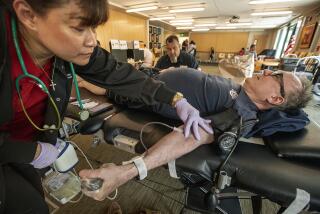HIV Case in Texas Is Linked to Donated Blood
- Share via
SAN ANTONIO — A Texas ranch hand undergoing surgery was infected with HIV in what is believed to be the first U.S. case of the virus being transmitted through donated blood since rigorous new screening technology was implemented three years ago.
A spokeswoman for the South Texas Blood and Tissue Center said only one patient received the tainted blood.
David Autrey, 51, of Chilton was infected with human immunodeficiency virus through a blood transfusion he received during emergency heart bypass surgery in August 2000 at Scott & White Hospital in Temple, officials at the San Antonio blood bank said.
Autrey said that he is taking drugs to combat the HIV but that his life is devastated.
“There’s no cure for this stuff, and this [HIV drug] cocktail is no fun,” Autrey told the San Antonio Express-News in Saturday’s editions. “I was looking forward to seeing all the grandkids grow up, but you know how it goes.”
Blood bank spokeswoman Shelley Valdez said the blood bank had located all the tainted blood. “We are certain that only Mr. Autrey received the blood.”
There are no other known cases of HIV being transmitted through donated blood since blood banks added new testing technology, said Dr. Michael Busch, a professor at UC San Francisco and an executive at Blood Centers of the Pacific.
However, while the testing process is highly sophisticated, it still is considered experimental and can fail to detect the virus in blood from donors who give blood soon after being exposed to HIV, he said.
The tainted blood came from a man who was a regular donor at the blood bank and who donated four times during 2000, said Dr. Norman Kalmin, president and chief executive of the San Antonio blood bank.
When the man donated in December 2000, his blood tested positive for HIV. Blood bank workers went through five years of previous donations.
Valdez said the procedure calls for the blood bank to contact hospitals that received the blood. The hospitals then contact the recipients and test them for HIV.
“The explanation is that the [donor] was recently exposed,” Kalmin said. “It hadn’t had the opportunity to multiply to levels that were detectable” in the automated testing.
In 1999, blood banks began nucleic amplification testing, which closes the window period of detecting tainted blood. For example, if a donor gave blood today, the test would show if the person was infected seven to 10 days earlier.
Experts say the chance of getting HIV from donated blood is 1 in 2 million to 3 million transfusions, and they stress that the nation’s blood supply is very safe.
More to Read
Sign up for Essential California
The most important California stories and recommendations in your inbox every morning.
You may occasionally receive promotional content from the Los Angeles Times.













